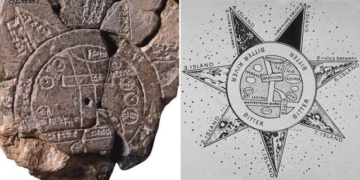Scientists believe that for every five exoplanets orbiting other stars, one will resemble Earth.
NASA has announced plans to launch the “Habitable Worlds Observatory” (HWO) by the end of this summer, aiming to identify 25 planets with environments suitable for life.
According to Science Alert, contracts have been awarded to three companies: BAE Systems, Lockheed Martin, and Northrop Grumman to research optics, mission design, and features of the next-generation telescope at a cost of $17.5 million.
HWO is expected to surpass the capabilities of the Nancy Grace Roman Space Telescope, which is nearly complete and scheduled for launch in 2027. In a statement, NASA provided specifics about this 10-year delayed mission aimed at searching for life.

The Habitable Worlds Observatory (HWO) will feature a large disk-shaped device to block “noise” light from stars, allowing for clearer observations of surrounding planets – (Graphic: NASA).
According to NASA, the main goal of the mission is to identify and directly image at least 25 potentially habitable worlds.
So far, NASA’s Transiting Exoplanet Survey Satellite (TESS) has identified over 5,000 other worlds, many of which are quite Earth-like. However, humanity can only glimpse these planets through graphics provided by the space agency, as capturing direct images of such distant worlds is exceedingly challenging.
Once direct images of at least 25 target planets are obtained, HWO will use spectroscopy to search for chemical signatures of life in the atmospheres of these planets, including gases like oxygen and methane.
Additionally, the observatory will offer new deep-space research capabilities that previous instruments could not provide.
The high-resolution images, a key investment for HWO, will not only offer insights into other planets but can also be utilized to study other cosmic structures.
In January of this year, NASA requested proposals to enhance and improve the technologies necessary for HWO.
The mission will include a disk-shaped device that can block light from the parent star of other planetary systems, thus helping to identify nearby planets obscured by that light, particularly small planets like Earth.
Moreover, NASA hopes to leverage this observatory to explore the most distant structures at the edge of the Solar System.
Ironically, due to the viewing angle, even though we have observed many other planets and galaxies billions of light-years away, we remain completely blind to our own Solar System.
Returning to potentially habitable worlds, the primary targets are planets located just a few dozen to a few hundred light-years away.
Scientists believe that one in five of the exoplanets out there could be habitable worlds, much like Earth. The challenge is that they are too distant, and current instruments cannot directly capture evidence of life on them. The Habitable Worlds Observatory promises to bring back that much-anticipated evidence.





















































